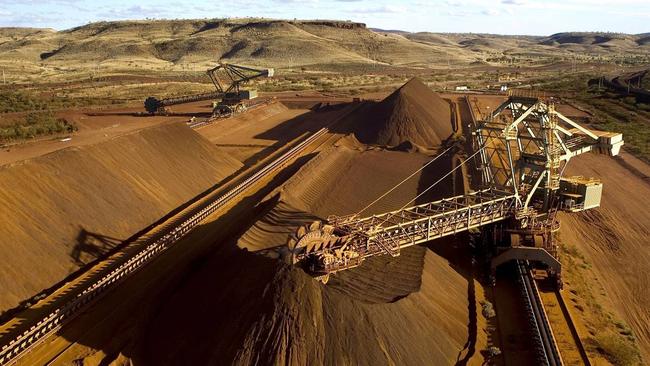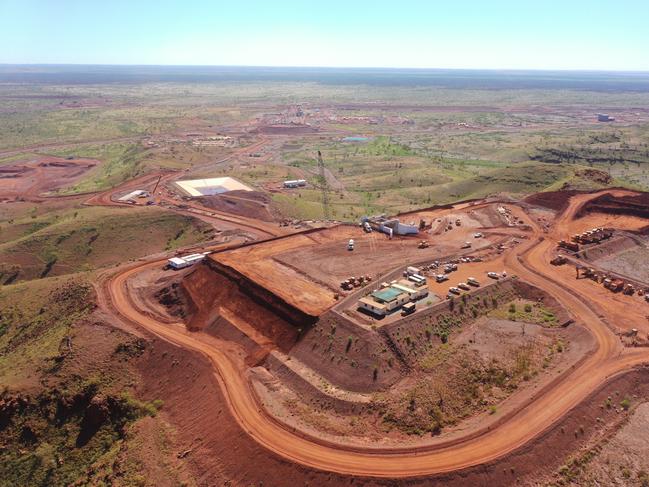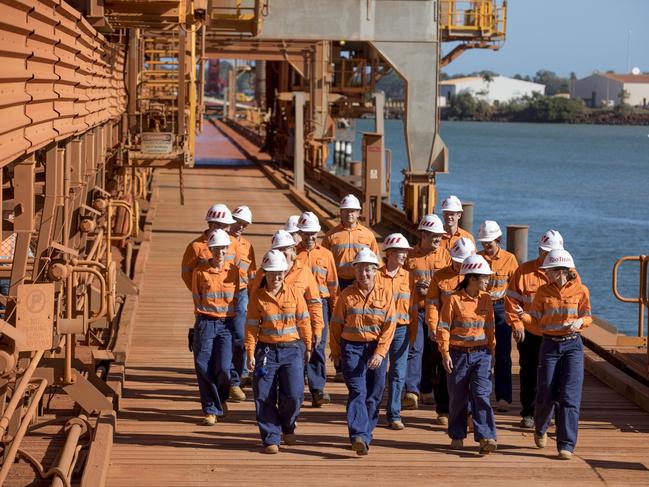Covid-19 crimps Rio Tinto iron ore with project delays and lower output
Rio Tinto failed to beat 2020 production levels in any of the mining giant's key commodities last year and the pandemic continues to limit its outlook.

Rio Tinto’s flagship iron-ore division faces significant challenges over the few months as WA’s mining industry braces for the impact of the reopening of borders, with the mining giant flagging ongoing troubles with ramping up output at its new Pilbara mines as the WA skills shortage bites.
Rio released its full-year production review on Tuesday, narrowly beating the bottom end of its revised 2021 iron-ore guidance in shipping 321.6 million tonnes from the Pilbara last year.
But it issued only cautious optimism for 2022, saying it expected to ship 320 to 335 million tonnes for the year – 5 million tonnes below its initial estimate for 2021, before the skills crisis in WA pushed back the completion of key new Pilbara mines.
That guidance is based on a “business as Covid-normal” basis, factoring in the current skills crisis but not the potential impact to the workforce if the Omicron variant repeats its performance on the east coast and spreads rapidly through the WA workforce.
Rio warned shareholders on Tuesday, however, that even cautious hopes for an improvement in its biggest money-spinning assets would be at risk from the wildfire spread of a new Covid-19 variant.
“Our guidance assumes development of the pandemic does not lead to government-imposed restrictions and widespread protracted cases related to new highly contagious variants with high severity, which could result in a significant number of our production critical workforce and contractor base being unable to work due to illness and/or isolation requirements,” the company said.
“This risk extends to prolonged interruption of service from a key partner or supplier which could lead to severely constrained operational activity of a key asset or project. This risk is exacerbated globally by tight labour markets and supply chain delays.”
The WA skills crisis has been exacerbated by the WA government’s attempts to protect its mining industry by locking down the state’s borders.
But the planned February 5 reopening of the state now looms as a fresh hurdle in what should be Rio’s banner year in getting its once-dominant iron-ore division back on track.
The legacies of chronic underinvestment in its Pilbara operations have largely been cleared away.

Its Gudai-Darri mine is nearing the start of operations, although Rio flagged another delay in first shipments on Tuesday, and it is understood the “mine scheduling” issues at its Brockman hub – first revealed in mid-2019 – have largely been resolved, with excess waste rock removed.
And Rio is also in the final stages of a mammoth review of heritage sites triggered by the Juukan Gorge disaster, meaning its mine planners are finally in a position to flesh out long-term plans.
But for the looming Omicron surge, still too uncertain to plan for, 2022 should be the year Rio is able to get serious about chasing down BHP and Fortescue and finding a way to reclaim its crown as the Pilbara’s cheapest iron ore producer.
Instead, the fresh warnings about the outlook for iron ore come amid a catalogue of delays and blowouts at key growth projects for the mining giant, with production across all of its key commodity divisions down compared to 2021.
Rio confirmed an additional $US175m blowout at its Oyu Tolgoi copper mine expansion in Mongolia and said its January 2023 deadline for first production from the project – last revised in its September quarter results – was again under revision from the impact of Covid-19 in the country and broader supply chain issues.
The company also pushed back the likely first production from its troubled Jadar lithium project in Serbia by at least a year, saying it would now occur “no earlier than 2027”.
Rio shipped 321.6 million tonnes of iron ore in 2021, just above the bottom end of the downgraded 320 to 325 million tonne target set in October.
The mining giant said its issues with finding skilled workers are ongoing, pushing back exports from the main plant at its new Gudai-Darri mine until the June quarter due to “labour access and supply chain quality issues”.
Rio’s annual iron-ore shipments fell 3 per cent from 2020 levels, and included 36.6 million tonnes of lower-grade SP10 iron ore – almost 250 per cent more than was shipped the previous year.
“SP10 products comprised a higher share of shipments in the fourth quarter as a result of delays in growth and brownfield mine replacement tie-in projects. As those mines ramp up through the first half of 2022, we will see SP10 gradually decrease and return to levels around 6 per cent of shipments in the medium term,” the company said.
Rio shipped 70.6 million tonnes of iron ore in the December quarter, including 15.5 million tonnes of SP10, down 4 per cent on the same time in 2020.
Rio failed to beat 2020 output levels in any of its key commodities, with copper production down 7 per cent for the year, to 494,000 tonnes, bauxite off 3 per cent, aluminium down 1 per cent and titanium dioxide down 9 per cent for the full year.
While output was up at Oyu Tolgoi’s open pit operations and at the Kennecott copper mine in the US, Rio’s total copper production was hit by a 17 per cent fall in its share of production at the BHP-operated Escondida mine in Chile, on the impact of the pandemic and falling grades at the giant mine.
Poor weather hit bauxite exports from Rio’s Amrun mine in Queensland, with outages at key refineries in Australia and Canada impacting alumina production.
And a three-month strike by workers at Rio’s Kitimat aluminium smelter in Canada was the major cause of lower aluminium output, the company said.

Rio offered only cautious optimism for a lift in its operational performance in 2022, keeping guidance largely in line with 2021 production levels.
Rio said it expects to ship 320 to 335 million tonnes of iron ore this year, and 54 to 57 million tonnes of bauxite – in line with the 54 million tonnes from this year.
Alumina guidance was also lifted only marginally from output of 7.9 million tonnes in 2021, to 8 to 8.4 million tonnes, with aluminium production also in line with this year’s 3.2 million tonne figure.
Rio said it expects a marginal improvement from its copper division, guiding output of 500,000 ton 575,000 tonnes of mined copper for 2022, up from 494,000 tonnes in 2021.
Rio shares closed down 38c to $109.65 on Tuesday.


To join the conversation, please log in. Don't have an account? Register
Join the conversation, you are commenting as Logout